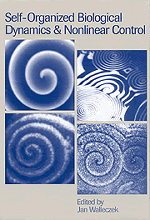 Self-Organized Biological Dynamics and Nonlinear Control
Self-Organized Biological Dynamics and Nonlinear Control Book contents
- Frontmatter
- Contents
- List of contributors
- Preface
- The frontiers and challenges of biodynamics research
- Part I Nonlinear dynamics in biology and response to stimuli
- Part II Nonlinear sensitivity of biological systems to electromagnetic stimuli
- Part III Stochastic noise-induced dynamics and transport in biological systems
- 10 Stochastic resonance: looking forward
- 11 Stochastic resonance and small-amplitude signal transduction in voltage-gated ion channels
- 12 Ratchets, rectifiers, and demons: the constructive role of noise in free energy and signal transduction
- 13 Cellular transduction of periodic and stochastic energy signals by electroconformational coupling
- Part IV Nonlinear control of biological and other excitable systems
- Index
11 - Stochastic resonance and small-amplitude signal transduction in voltage-gated ion channels
Published online by Cambridge University Press: 14 August 2009
- Frontmatter
- Contents
- List of contributors
- Preface
- The frontiers and challenges of biodynamics research
- Part I Nonlinear dynamics in biology and response to stimuli
- Part II Nonlinear sensitivity of biological systems to electromagnetic stimuli
- Part III Stochastic noise-induced dynamics and transport in biological systems
- 10 Stochastic resonance: looking forward
- 11 Stochastic resonance and small-amplitude signal transduction in voltage-gated ion channels
- 12 Ratchets, rectifiers, and demons: the constructive role of noise in free energy and signal transduction
- 13 Cellular transduction of periodic and stochastic energy signals by electroconformational coupling
- Part IV Nonlinear control of biological and other excitable systems
- Index
Summary
Introduction
Voltage-gated ion channels are crucial ‘building blocks’ in various systems of signal transduction and processing in living organisms. They are ultimately responsible for information flow at several hierarchical levels of biological complexity that include signal sensing (Lu and Fishman, 1994) and generation of nerve action potentials (Hille, 1992), and are crucially important in synaptic transmission and other intercellular communications (Alberts et al., 1994). Preceding biologically inspired work on the role of external noise in electrical signal transduction concentrated on rather complex objects such as neurons (Bulsara et al., 1994; Pei et al., 1996; Chapeau-Blondeau et al., 1996; Longtin, 1997; Plesser and Tanaka, 1997) and neuronal ensembles (Gluckman et al., 1996; Chialvo et al., 1997). It was demonstrated that addition of random fluctuations, or noise to the input of these systems could improve the transmission efficiency for small input signals. Yet even more elaborate physiological systems showing similar properties include isolated sciatic nerves of a toad (Morse and Evans, 1996; Moss et al., 1996), rat SA1 cutaneous mechanoreceptors (Collins et al., 1996a), mechanosensory transduction pathways in arthropods (Douglass et al., 1993; Levin and Miller, 1996), and human sensory perception (Cordo et al., 1996; Collins et al., 1996b; Chiou-Tan et al., 1996; Simonoto et al., 1997). The counterintuitive phenomenon of noise-improved signal transduction, called ‘stochastic resonance’ – first introduced as a possible explanation for the periodic recurrences of the Earth's ice ages (Benzi et al., 1981) – has now been established empirically for many macroscopic systems and, for some of them, is understood theoretically (Wiesenfeld and Moss, 1995; Gammaitoni et al., 1998; see also Moss, Chapter 10, this volume).
- Type
- Chapter
- Information
- Self-Organized Biological Dynamics and Nonlinear ControlToward Understanding Complexity, Chaos and Emergent Function in Living Systems, pp. 257 - 280Publisher: Cambridge University PressPrint publication year: 2000
- 1
- Cited by


